Famiglia
Author: Friedemann Friese
Publisher: 2F-Spiele
Year: 2010
review by

| x |
|
|
|
|
|
|
|
|
|
|
|
|
|
|
|
|
|
|
|
|
|
|
|
|
|
|
|
|
|
|
|
|
|
|
|
|
|
|
|
|
|
|
|
|
|
|
|
|
|
|
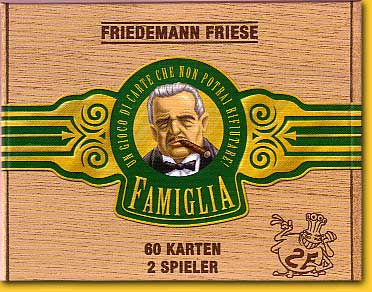 |
Assemble the strongest gang and rule the city! The street, portrayed by a row of cards, is full of shady customers from four differently coloured families. The players can recruit these gang members to form their own gang. Each of the families has a special ability, and the cards have a value ranging from 0 to 4 -corresponding from 0 to 15 points. The player with the most powerful members in his personal street gang wins the game!
|
|
|
| x |
|
|
|
|
|
|
|
|
|
|
|
|
|
|
|
|
|
|
|
|
|
|
|
|
|
|
|
|
|
|
|
|
|
|
|
|
|
|
|
|
|
|
|
|
|
|
|
|
|
|
|
Each turn a player may recruit a new gang member from the street; a '0' can be recruited at no cost, but all other cards require two cards of the same colour with a value that is one lower than the recruited card. This means that a green '3' card requires two green '2' cards. The player adds the new card to his hand. Of the two gang members used to recruit the new member he may take one back into his hand, and the other one is placed face-up on the table. These face-up gang members are exhausted from their duties and can't be used anymore, but they do score victory points at the end of the game!
|
|
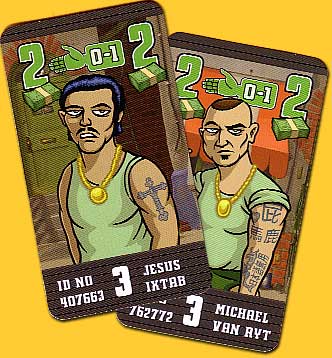 |
|
|
| x |
|
|
|
|
|
|
|
|
|
|
|
|
|
|
|
|
|
|
|
|
|
|
|
|
|
|
|
|
|
|
|
|
|
|
|
|
|
|
|
|
|
|
|
|
|
|
|
|
|
|
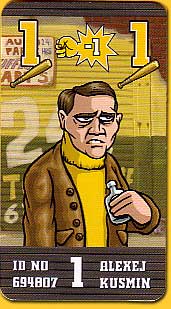 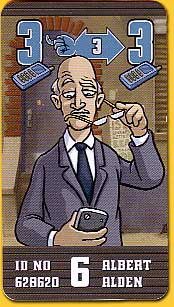 |
To facilitate the recruitment of new gang members the special abilities of the families can be used. A yellow card intimidates other individuals in the street, thus temporarily reducing their value. For example, a red '4' would normally require two red '3' cards, but when a yellow card is used, its value is reduced to '3' and only two red '2' cards are required -are you still there? The yellow card is placed face-up on the table -its gang member being exhausted- and can't be used again. But: with the special ability of the blue family, exhausted gang members can be revitalised! Blue cards allow the exchange of exhausted cards for hand cards. |
|
|
| x |
|
|
|
|
|
|
|
|
|
|
|
|
|
|
|
|
|
|
|
|
|
|
|
|
|
|
|
|
|
|
|
|
|
|
|
|
|
|
|
|
|
|
|
|
|
|
|
|
|
|
| The green family can be used as a wild card to recruit a gang member of any other colour, and the red family members do nothing special but yield more victory points at the end of the game. The game ends when the draw pile has been exhausted for the second time. Players count the victory points -both hand- and exhausted cards!- and the player with the highest score wins! |
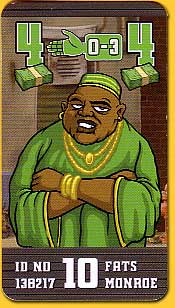 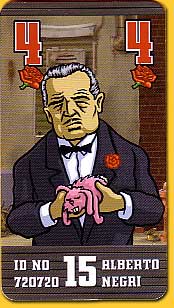 |
|
|
| x |
|
|
|
|
|
|
|
|
|
|
|
|
|
|
|
|
|
|
|
|
|
|
|
|
|
|
|
|
|
|
|
|
|
|
|
|
|
|
|
|
|
|
|
|
|
|
|
|
|
|
| x |
|
|
|
|
|
|
|
|
|
|
|
|
|
|
|
|
|
|
|
|
|
|
|
|
|
|
|
|
|
|
|
|
|
|
|
|
|
|
|
|
|
|
|
|
|
|
|
|
|
|
| x |
|
|
|
|
|
|
|
|
|
|
|
|
|
|
|
|
|
|
|
|
|
|
|
|
|
|
|
|
|
|
|
|
|
|
|
|
|
|
|
|
|
|
|
|
|
|
|
|
|
|
 |
|
|
|
|
|
|
|
|
|
|
|
|
|
|
|
|
|
|
|
|
|
|
|
|
|
|
|
|
|
|
|
|
|
|
|
|
|
|
|
|
|
|
|
|
|
|
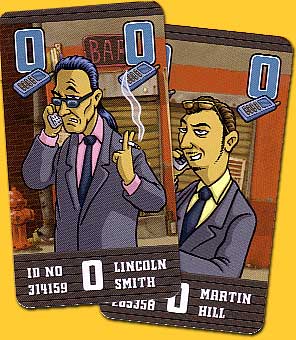 |
|
It is very well possible that some players are not attracted by the theme of 'Famiglia'. But there is good news for those who do not enjoy recruiting the type of people that shoot others in the kneecaps and put horse heads in their beds: 'Famiglia' is an abstract game, and the theme is of no importance whatsoever. |
|
|
| x |
|
|
|
|
|
|
|
|
|
|
|
|
|
|
|
|
|
|
|
|
|
|
|
|
|
|
|
|
|
|
|
|
|
|
|
|
|
|
|
|
|
|
|
|
|
|
|
|
|
|
|
Because the iconography on the cards is not very clear and not consistent, and because there is no strong theme to serve as a mnemonic device, the special abilities of the four families are difficult to remember in detail. This is a pity, since they are extremely important in the game: he who does not use them wisely is a sure loser!
|
|
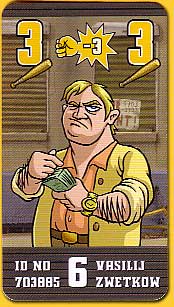 |
|
|
| x |
|
|
|
|
|
|
|
|
|
|
|
|
|
|
|
|
|
|
|
|
|
|
|
|
|
|
|
|
|
|
|
|
|
|
|
|
|
|
|
|
|
|
|
|
|
|
|
|
|
|
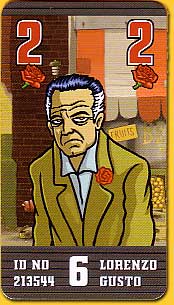 |
|
The red cards are much more valuable than the other colours, so usually the player with the majority of red cards wins the game. This means that the player that happens to encounter more red '0' cards has a big advantage. This can partly be compensated by using the families' special abilities, for example by using a green -wild- card as a red card, but nonetheless the role of the red cards is too important. As soon as it becomes apparent that one of the players is getting away with more than his share of red cards, the outcome is already known, and then the rest of the game is not very exciting anymore |
|
|
|
| x |
|
|
|
|
|
|
|
|
|
|
|
|
|
|
|
|
|
|
|
|
|
|
|
|
|
|
|
|
|
|
|
|
|
|
|
|
|
|
|
|
|
|
|
|
|
|
|
|
|
|
|
'Famiglia' is a nice two-player puzzle game. The special abilities of the families add the necessary depth and complexity; otherwise it would be a rather shallow and random card game. Because the card pile has to be exhausted twice, the game is rather long for a card game, and especially if it is already clear who the winner will be, it gets a bit boring.
© 2011 Barbara van Vugt
Famiglia, Friedemann Friese, 2F-Spiele, 2010 - 2 players, 10 years and up, 30 minutes
|
|
|
|
  |
|
|
|
|
|
|
|
|
|
|
|
|
|
|
|
|
|
|
|
|
|
|
|
|
|
|
|
|
|
|
|
|
|
|
|
|
|
|
|
|
|
|
|
|
|
|
  |
|
|
|
|
|
|
|
|
|
|
|
|
|
|
|
|
|
|
|
|
|
|
|
|
|
|
|
|
|
|
|
|
|
|
|
|
|
|
|
|
|
|
|
|
|
|
| x |
|
|
|
|
|
|
|
|
|
|
|
|
|
|
|
|
|
|
|
|
|
|
|
|
|
|
|
|
|
|
|
|
|
|
|
|
|
|
|
|
|
|
|
|
|
|
|
|
|
|
| x |
|
|
|
|
|
|
|
|
|
|
|
|
|
|
|
|
|
|
|
|
|
|
|
|
|
|
|
|
|
|
|
|
|
|
|
|
|
|
|
|
|
|
|
|
|
|
|
|
|
|
 |
|
|
|
|
|
|
|
|
|
|
|
|
|
|
|
|
|
|
|
|
|
|
|
|
|
|
|
|
|
|
|
|
|
|
|
|
|
|
|
|
|
|
|
|
|
|
 |
|
|
|
|
|
|
|
|
|
|
|
|
|
|
|
|
|
|
|
|
|
|
|
|
|
|
|
|
|
|
|
|
|
|
|
|
|
|
|
|
|
|
|
|
|
|
| x |
|
|
|
|
|
|
|
|
|
|
|
|
|
|
|
|
|
|
|
|
|
|
|
|
|
|
|
|
|
|
|
|
|
|
|
|
|
|
|
|
|
|
|
|
|
|
|
|
|
|
 |
|
|
|
|
|
|
|
|
|
|
|
|
|
|
|
|
|
|
|
|
|
|
|
|
|
|
|
|
|
|
|
|
|
|
|
|
|
|
 |
|
|
|
|
|
|
|
|
|
|
|
|
|
|
|
|
|
|
|
|
|
|
|
|
|
|
|
|
|
|
|
|
|
|
|
|
|
|